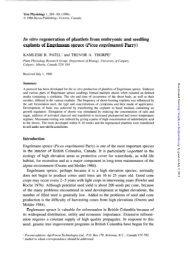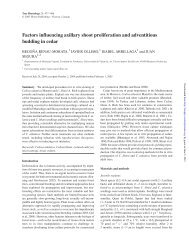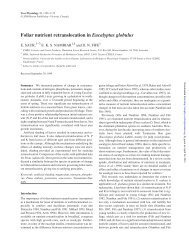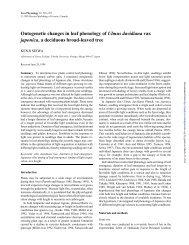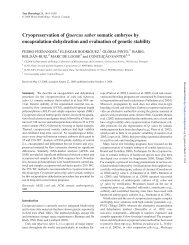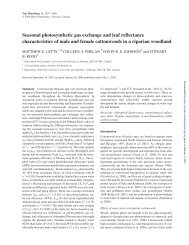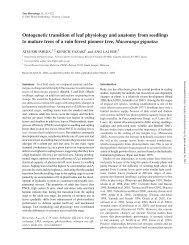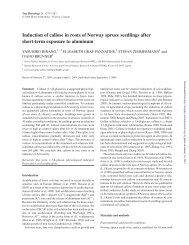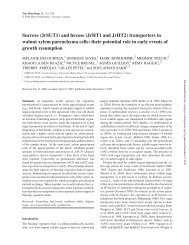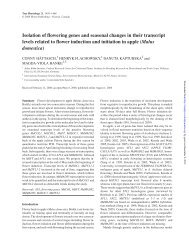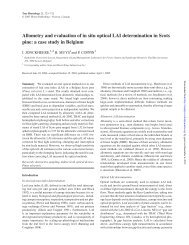Hara: the effect of xylem structures - Tree Physiology
Hara: the effect of xylem structures - Tree Physiology
Hara: the effect of xylem structures - Tree Physiology
You also want an ePaper? Increase the reach of your titles
YUMPU automatically turns print PDFs into web optimized ePapers that Google loves.
like our case, <strong>the</strong>n embolized vessels might be refilled only<br />
slightly—not only quickly but even overnight.<br />
The high degree <strong>of</strong> 1-h rapid refilling <strong>of</strong> <strong>the</strong> embolized<br />
vessels in B. platyphylla, which is observed in all size<br />
classes <strong>of</strong> both current and 1-year-old <strong>xylem</strong>, provided rapid<br />
recovery <strong>of</strong> <strong>the</strong> hydraulic conductivity (Figure 6). Embolized<br />
vessels <strong>of</strong> <strong>the</strong> current <strong>xylem</strong> were almost refilled<br />
by taking sufficient times <strong>of</strong> 12 h. It is notable that about<br />
20% or more <strong>of</strong> vessels <strong>of</strong> any size class in 1-year-old <strong>xylem</strong><br />
had been embolized, which indicates that cavitation in<br />
1-year-old <strong>xylem</strong> vessels cannot be refilled during a single<br />
day (17.10 ± 13.67% (mean ± SD, n = 3) in PLC <strong>of</strong> B.<br />
platyphylla stems at 24 h after rewatering, data not shown).<br />
Therefore, although <strong>the</strong> extent <strong>of</strong> conducting vessels did<br />
not affect <strong>the</strong> <strong>xylem</strong> specific conductivity for different water<br />
status irrespective <strong>of</strong> <strong>xylem</strong> age (Figure 7), different refilling<br />
patterns between <strong>xylem</strong> ages might leave insufficient<br />
time for refilling, with some structural fault in 1-year-old<br />
<strong>xylem</strong>, such as pit degradation (Sperry et al. 1991) or perhaps<br />
aging itself, even though both aged vessels were fully<br />
conducted under well-watered conditions. In contrast, for Q.<br />
serrata, some vessel refilling in current <strong>xylem</strong> was apparent<br />
in each size class, especially more in small size classes than<br />
in larger size classes, while vessels <strong>of</strong> <strong>the</strong> 1-year-old <strong>xylem</strong><br />
remained embolized after rewatering (Figure 5). This might<br />
result from greater sensibility <strong>of</strong> smaller vessels for refilling<br />
mechanically or priority <strong>of</strong> small vessels phenologically<br />
than that <strong>of</strong> larger vessels in relation to preparation for next<br />
year’s growth.<br />
Pits are pathways not only <strong>of</strong> water but also <strong>of</strong> air during<br />
drought-induced cavitation (Sperry and Tyree 1988, Tyree<br />
and Zimmermann 2002). In relation to <strong>the</strong> <strong>xylem</strong> structure,<br />
our results, showing that dependence <strong>of</strong> cavitation on vessel<br />
size was seemingly observed in ei<strong>the</strong>r <strong>the</strong> studied species or<br />
o<strong>the</strong>r species (Hargrave et al. 1994), imply that <strong>the</strong> pit distribution<br />
depends on <strong>the</strong> vessel size. As reported by Wheeler et<br />
al. (2005) and Hacke et al. (2006), <strong>the</strong> total pit area per vessel<br />
determines <strong>the</strong> safety to cavitation interspecifically. Considering<br />
our cases <strong>of</strong> both species intraspecifically, larger vessel<br />
diameter might imply a higher risk <strong>of</strong> cavitation.<br />
Highly specific conductivity <strong>of</strong> Q. serrata was apparent<br />
throughout <strong>the</strong> experiments, even in <strong>the</strong> presence <strong>of</strong> much<br />
native embolism in current <strong>xylem</strong> and <strong>of</strong> nonconducting 1year-old<br />
<strong>xylem</strong> compared with B. platyphylla, indicating<br />
that Q. serrata holds ‘disposable’ <strong>xylem</strong> vessels and can<br />
compensate water conducting with its remaining efficient<br />
functional vessels. These results are explainable by <strong>the</strong><br />
trade-<strong>of</strong>f between <strong>the</strong> conducting efficiency and cavitation<br />
safety (Tyree and Zimmermann 2002). Large vessels provide<br />
dramatically high efficiency <strong>of</strong> water conduction but<br />
simultaneously provide less safety. Hacke et al. (2006) also<br />
explained that <strong>the</strong> remaining larger vessels under drought<br />
are more efficient for water conduction than smaller ones,<br />
even if some larger ones were sacrificed by cavitation in a<br />
so-called sacrificial strategy. Fur<strong>the</strong>rmore, such ‘disposable’<br />
<strong>xylem</strong> vessels <strong>of</strong> Q. serrata can associate with stronger sto-<br />
LOSS OF XYLEM CONDUCTIVITY AND ITS RECOVERY 9<br />
matal regulation <strong>of</strong> transpiration in ring-porous species<br />
(Bush et al. 2008) in respect <strong>of</strong> preventing vessels from cavitation.<br />
Consequently, Q. serrata might retain a stable water<br />
supply under daily drought and have low vessel-filling ability.<br />
In less efficient and small-vessel-bearing species, on <strong>the</strong><br />
o<strong>the</strong>r hand, <strong>the</strong>y must meet <strong>the</strong> likely demand for water<br />
conduction by holding numerous safer vessels (vessel-packing<br />
strategy; Hacke et al. 2006). In fact, Ψ<strong>xylem</strong> at which <strong>the</strong><br />
cavitation for B. platyphylla started was very close to that<br />
level resulting in substantial or complete loss <strong>of</strong> conductivity<br />
(<strong>the</strong> midday minimum Ψ leaf <strong>of</strong> 3-year-old B. platyphylla<br />
was around −2.0 MPa in October 2007; data not shown).<br />
For that reason, recovery from cavitation might be necessary<br />
for sufficient water supply throughout <strong>the</strong> growth season:<br />
<strong>the</strong> high extent <strong>of</strong> vessel refilling observed here is<br />
explainable as a safety net to regain hydraulic efficiency<br />
that was once lost. In o<strong>the</strong>r words, B. platyphylla holds ‘reusable’<br />
<strong>xylem</strong> vessels.<br />
This study revealed different hydraulic traits <strong>of</strong> Q. serrata<br />
and B. platyphylla. Irrespective <strong>of</strong> Q. serrata showing<br />
no marked vessel refilling and recovery <strong>of</strong> hydraulic conductivity,<br />
<strong>the</strong>y might perform <strong>the</strong>ir water conduction using<br />
<strong>the</strong> remaining large vessels, which are still more efficient<br />
than smaller and inherently safer vessels. In contrast, B.<br />
platyphylla, which has smaller vessels, retained water conduction<br />
because <strong>of</strong> its capacity <strong>of</strong> rapid vessel refilling<br />
even though vessels lose <strong>the</strong>ir conductivity through water<br />
stress. As indicated for Q. serrata and B. platyphylla, if<br />
it were commonly appropriate that ring-porous and diffuse-porous<br />
species would hold ‘disposable’ and ‘reusable’<br />
vessels in <strong>the</strong> <strong>xylem</strong>, respectively, <strong>the</strong>n knowledge <strong>of</strong> this<br />
new aspect <strong>of</strong> <strong>xylem</strong> recovery after water-stress release<br />
might provide an advanced interpretation <strong>of</strong> a water-conducting<br />
strategy toward water stress for plants.<br />
Acknowledgments<br />
We are grateful to Dr. K. Sakamoto and Dr. M. Hirobe for <strong>the</strong>ir insightful<br />
comments. Comments from anonymous reviewers were<br />
very helpful for improving <strong>the</strong> final version. This study was supported<br />
by a Grant-in-Aid for JSPS Fellows (21.5030) and was conducted<br />
under <strong>the</strong> Cooperative Research Program <strong>of</strong> Arid Land<br />
Research Center, Tottori University.<br />
References<br />
Brodribb, T.J. and N.M. Holbrook. 2004. Diurnal depression <strong>of</strong> leaf<br />
hydraulic conductance in a tropical tree species. Plant Cell Environ.<br />
27:820–827.<br />
Brodribb, T.J., N.M. Holbrook, E.J. Edwards and M.V. Gutiérrez.<br />
2003. Relations between stomatal closure, leaf turgor and <strong>xylem</strong><br />
vulnerability in eight tropical dry forest trees. Plant Cell Environ.<br />
26:443–450.<br />
Bucci, S.J., F.G. Scholz, G. Goldstein, F.C. Meinzer and L. da S. L.<br />
Sternberg. 2003. Dynamic changes in hydraulic conductivity in<br />
petioles <strong>of</strong> two savanna tree species: factors and mechanisms contributing<br />
to <strong>the</strong> refilling <strong>of</strong> embolized vessels. Plant Cell Environ.<br />
26:1633–1645.<br />
TREE PHYSIOLOGY ONLINE at http://www.treephys.oxfordjournals.org<br />
Downloaded from<br />
http://treephys.oxfordjournals.org/ by guest on December 10, 2012



